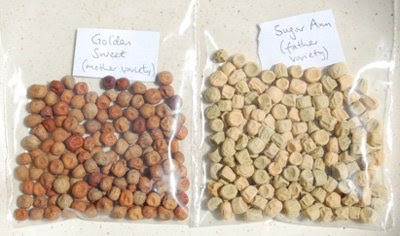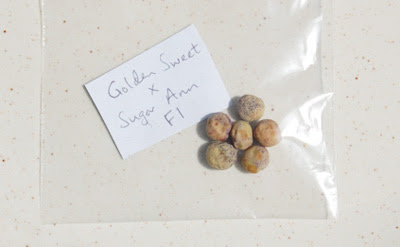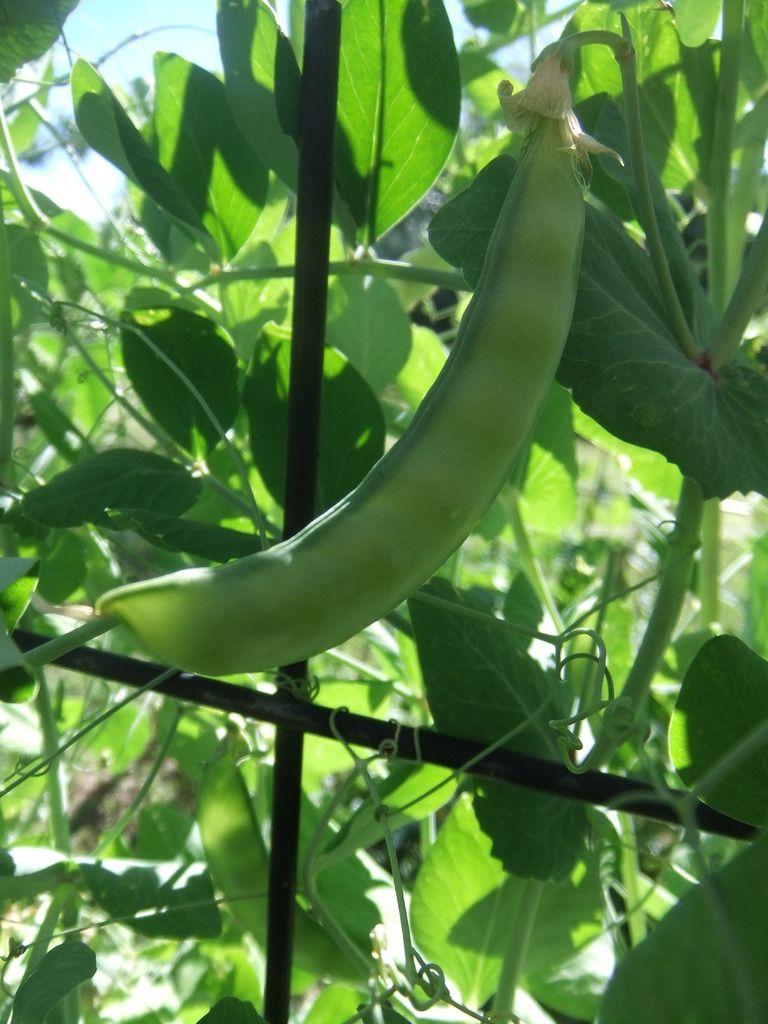|
|
Post by oldmobie on Jun 26, 2015 14:47:01 GMT -5
This is the first year that I've had enough pea production to justify seed saving. I started with Joseph Lofthouse's landrace shelling peas, planted very thickly. Something in the mix liked the conditions, and now I'm drying seeds.  I understand the natural outcrossing rate is near zero. Hand polination looks like it exceeds my skill, or at least my patience. So I'm left with selection. Selecting what grows well for me is automatic. Is there value in selecting the largest seed? Most seeds/ pod? Segregating the seeds from the last plant to die? Any other traits I should try to select for? (I didn't taste them this year. I'll try to select for taste in the future.) |
|
|
|
Post by Joseph Lofthouse on Jun 26, 2015 16:30:52 GMT -5
I have a bug that lays it's eggs in the green peas, and then the larva eat the pea from the inside out after it is dried... So I dry them as quick as possible, until they shatter when hit with a hammer, and toss them in a freezer for a few days to kill the bugs.
One time, I found a pea in my landrace that produced seed about 10 days earlier than the rest of the patch. I saved seed from that separate, and today it's a separate variety. Mostly I don't do selection these days on the landrace peas... Whatever produces the most seeds has the most offspring. I am working on making a new shelling pea... I have to taste seeds from every plant for that one, and only save seeds that taste good to me. I am also selecting these for larger seeds, and larger pods.
In my landrace, there used to be a variety that produced huge pods, and lots of huge peas. But it didn't thrive here, so it bit the dust, though there might still be some of it running around in seeds that I sent away from my garden.
I keep telling myself that I should select for a pea that thrives in hot weather... But I haven't done that yet.
|
|
|
|
Post by templeton on Jun 27, 2015 2:31:18 GMT -5
Wow, oldmobie , where to start? Big seeds provide more nutrients to the young plant so are more likely to sprint out of the ground at germination. Carol Deppe selects for vigorous early growth to outgrow the munching pests. As Joseph says, yield almost self selects - the most productive plants produce the most seed.Wrinkled seed contains one of the genes for sweetness=delayed starch production. flavor of dried peas will be driven in part by the seed coat coloration I would guess, but that is likely to be maternal tissue. Selecting for more seeds per pod might be a self limiting trait - I would guess that overall productivity is constrained by the plant's physiology rather than the number of seeds in a pod, so more seeds per pod likely means less pods overall - but I'm just guessing. Don't discount cross pollination - it sounds fiddly, but I've even managed it with a raging hangover man flu, so it's not that difficult. Planting in groups will give you some idea of the variation between groups and within groups, so i recommend it. Height, disease resistance, earliness to flower, stem strength, pod holding ability - how long the pods stay harvestable - would be interesting. I'm looking at peduncle length - long ones stick out of the plant and make harvesting easy. Tenderness of tips for stirfry, ditto tendrils. Beauty is not to be discounted, and when you've got all those under control I'd be looking for the ability to speak a foreign language, and how it looks in a bikini tuxedo  T |
|
|
|
Post by keen101 (Biolumo / Andrew B.) on Jun 27, 2015 11:34:27 GMT -5
I keep telling myself that I should select for a pea that thrives in hot weather... But I haven't done that yet. Each year i try to grow peas i inadvertently plant them late, and they always seem to be setting pods in June and July. Right now all my peas are still alive and still growing quite good. (although they have been amended by water). But even so, i may be inadvertently selecting my peas for heat tolerance. Ironically the one which may being selected for this the most might be the Biskopens pea, which originates in Scandinavia, since it has a history of setting pods extremely late in the season. But in order to survive my conditions they must adapt at least some. I can help them a little when needed, but otherwise this show is all theirs. I imagine that's how we got most of the original pea cultivars. They didn't know about genetics back then, there may have been some smart people other than Mendel who knew crossing pollen would cross peas too, but otherwise most were probably just selected by hand over time. It's still a good method. Nature seems to produce some interesting things on her own now and again. |
|
|
|
Post by steev on Jul 1, 2015 0:37:23 GMT -5
"Bikini tuxedo"? That's just sick; flat-on-a-mattress is proper.
|
|
|
|
Post by keen101 (Biolumo / Andrew B.) on Jul 1, 2015 14:03:11 GMT -5
I've been thinking about how to identify F1 hybrids from the seed coat mottling effect. Traditionally most F1 hybrids should show phenotypic differences in their seed coat from either parent variety. But it's hardly a guarantee. Especially if both parent varieties have similar seed coat colors and traits. It seems more reliable on distinct different varieties. Still worth considering though. Here is some info from Mendel himself: and great information from Rebsie Fairholm: daughterofthesoil.blogspot.com/2008/09/joy-of-genes-illustrated.html  |
|
|
|
Post by ferdzy on Jul 4, 2015 8:52:16 GMT -5
I've had impressive results from selecting peas and beans for seed quality. For dried beans I have literally doubled my crop from the same space, and I suspect peas are not far behind.
We grow in 5' wide beds. What we do, is we plant 3 double rows to grow up strings, and leave the middle row for seed. From that, when the plants are dry, I select the plants with the most pods; say the top producing 1/3 of them. By nature and by preference, that will tend to be plants that produce 2 or more pods per node. Then, from amongst that set of plants I select the pods with the highest seed count. I actually sit there of an autumn evening and put them into little bowls labelled by number. It's tedious, but you can do it while watching TV or whatever, and the results, as I say, have been pretty amazing.
I'm not actually sure it was the right thing to do with Amish Snap. Production is way up, but also the pea-pods are getting to be very large. I might like to stop selecting 7 seeders and aim for 5 seeders, although the double-pod trait is really nice.
If you are growing peas or beans for dried, it is of course even easier - you entire crop becomes your potential saved seeds.
|
|
|
|
Post by templeton on Jul 4, 2015 17:24:12 GMT -5
ferdzy, with the plants all tangled, how do you sort by plant, rather than pod? By the time my seeds are drying down the culms just shatter, so its very difficult to know which bit belongs to which plant. In one growout I traced every culm from bottom to top, using different coloured plastic clothes pegs to tag each branching culm - did I say tedious? T
|
|
|
|
Post by ferdzy on Jul 4, 2015 20:07:28 GMT -5
Maybe I pick them sooner than you do? I don't usually have anything shatter, but it is very tedious, no question. I lay everything out on a drop cloth in the garage when I work.
|
|
|
|
Post by Joseph Lofthouse on Jul 4, 2015 21:33:36 GMT -5
I've had impressive results from selecting peas and beans for seed quality. For dried beans I have literally doubled my crop from the same space When I am careful and plant/harvest dry beans type-to-row, I can measure up to 3X difference in productivity between different varieties. Right now I am as interested in diversity as I am in productivity. But I write the productivity on the seed packet, so if I ever really need a crop for food, I can plant only the most productive. |
|
|
|
Post by keen101 (Biolumo / Andrew B.) on Jul 13, 2015 23:43:43 GMT -5
 This is a photo of my selections of Dwarf Gray Sugar peas that only had constricted pods. As you can see these look quite different from most of the peas shown as Dwarf Gray Sugar, but not all. From what i've seen there are two phenotypes for dwarf gray sugar. I'm quite happy with this selection. Not only is it one of the few peas in my collection that have constricted pods, it is now one of the only ones with curved pods! I quite like the look of them. They are pretty close to Kent Blue and the pictures Rebsie posted on her blog. And i didn't create these from a cross, just simple selection based on observed differences.  |
|